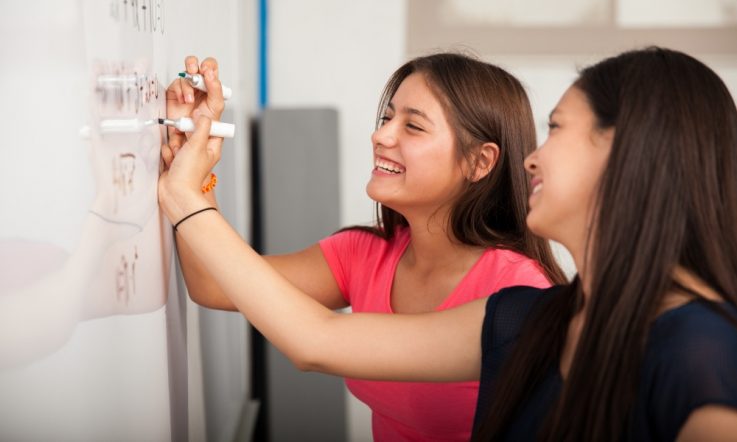Thank you for downloading this episode of Teacher magazine's Global Education podcast series – I'm Jo Earp. Today I'm talking to Dr Kevin Anthony Perry about a collaborative research project exploring classroom wellbeing, learning and inclusion from the perspectives of children and young people. Over the last two years the academic, from the University of Aalborg in Denmark, has carried out focus group interviews with 30 different groups of students followed by six months of classroom observations in five classes. I caught up with him at this year's Excellence in Professional Practice Conference and started by asking him to share some of the main research findings.
Kevin Anthony Perry: Quality relationships between students themselves makes a very positive difference to the learning and wellbeing in the school. Every child needs at least one good friend during the day to feel valued, acknowledged and cared about and part of a fellowship. Another significant finding is that the relationship between the student and the teacher is cardinal in relation to enhancing student learning, classroom wellbeing and of course fellowship. Students said that they prefer teachers who are fair, just and consequent and who demonstrate care and interest for their individual student …
Most students said that good explanations by teachers makes a huge difference to the motivation in school and can either block or promote learning. Students made a distinction between teachers and instructors. So, I said ‘okay, what do you mean?', ‘well, a teacher is somebody that wants to be there. A teacher is somebody that shows they care about you, they give a bit of themselves, they know you basically and we know them. An instructor is somebody that comes along, they throw their subject matter at you and they leave again, we don't get to know them, we don't get to trust them.' So, to build trust means giving a bit of yourself but also showing that you really want to be there in the same room as the students, and that enhances their learning experience – this is what this research shows – but also their sense of community.
Jo Earp: So, can you perhaps give us a practical example or a couple of examples, of the kinds of things that you observed?
KP: Yeah, well one thing that I've named the inclusive teacher-child relationship, was something that I observed on several occasions and it's how teachers actually start off the class. On the morning, well, it would be a morning ritual. One really good example was: the teacher she comes in the class, her communication is really spot on, she's upright, she's got this ‘teacher stare' you know, she gives eye contact and while this is going on I'm observing the class and I'm watching the children and they're all sitting there really expectantly, it's like they're ready to burst, you know?
She stands there, she's got the iPad, middle of the class and she starts reading out every single kid's name … ‘Emile – how did it go at football yesterday? Sarah – how's your horse? Jamie – how's your father, he's been ill lately?' She's got this very small, 10 second window with every single child in the class. It's something she prioritises and it's something that builds up an individual contact with every single child, but at the same time she's building up the full class contact. The children feel safe with her, they know her, she knows them and it shows that she knows them because she knows something about each individual child and you can see that the children really appreciate that.
I saw a couple of poor examples of greeting rituals. One example was where the teacher comes in, it's a teacher that they don't know very well, a new teacher to them. Of course, the teacher wants to try and initiate a good contact, her heart is in the right place, but I think she hasn't read the class very well, she's very much in their face. She comes over, puts her hand out, shakes their hand and … the problem is that the kids don't know her, so some of the shy kids pull away and also … her handshake, her grip is too tight so she hurts their fingers. Maybe two or three kids they thought it was fine, they're very social kids, outgoing kids.
Afterwards when I spoke to some of the students I said ‘well, I noticed that you were a bit reluctant to shake the teacher's hand. Can you tell me a bit more about it?' Well, the main message was ‘we don't know her' and some of the boys were saying ‘oh god, she grips your hand too tight, it hurts my fingers you know?' So the message is I think is that it's really good to do these morning ritual things and try and break that ice, but you've also got to consider that the group of children you're going to try and initiate this contact with, if they don't know you it's a big disadvantage.
JE: As a result of the research then, what are the implications for teachers working on the ground?
KP: In relation to all of our qualitative research and all the findings, I think it's really important for teachers, at the face-to-face level, they've got to prioritise building trust and positive relationships with students – that's really cardinal for promoting learning, classroom wellbeing and fellowship. Plus, I think teachers really must prioritise creating space for reflection on their own practice and maybe it would be good that teachers could actually observe each other in the class to try and help themselves before the classroom relationships actually deteriorate.
Make learning motivating for all students, because what we've seen is that some students exclude themselves if they don't feel included in the lesson – so, try and make all learning motivating for the students, where every student feels included and seen. You've got to be acknowledged in the classroom to feel part of it.
Then become ‘classroom wise', understand the mutual evaluation mechanisms because every student evaluates every teacher that comes in the classroom and they regulate their behaviour based on their evaluation. So, teachers have got to be aware of this – you're not the only one doing evaluations, students are evaluating you …
Then communication is vital, try and use clear and consistent communication, both verbal and non-verbal communication is really significant – body language, the tone of voice, your movement and your facial expressions.
A lot of this stuff, what our research shows from the perspective of students is you don't need to use a lot of money – it's about building relationships, trustworthy relationships, which is more about the way you act with people, the way you meet kids when they come in … ‘hi, good morning,' small things that don't cost a lot of money, it's about changing mindsets really and knowing the value of good trustworthy relationships.
JE: That's great, well, you've been presenting at the Excellence in Professional Practice Conference this week and thank you very much for talking to Teacher magazine.
KP: Thanks for inviting me, it's been a pleasure.
That's all for this episode of Global Education. To download all of our podcasts for free, visit acer.ac/teacheritunes or www.soundcloud.com/teacher-acer. To access the latest articles, videos and infographics visit www.teachermagazine.com.au.
Dr Kevin Anthony Perry was one of the presenters at this year's Excellence in Professional Practice Conference (EPPC).
To read more articles on EPPC visit the Teacher archive.



